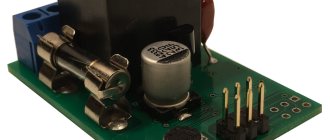Reason is given to man in order to make physical labor easier or to get rid of it altogether. This article is dedicated to a wood splitter, which you can make with your own hands from available materials. Such a wood splitter will cost you much less than a purchased one. The machine is assembled on the basis of an engine from a washing machine, and the necessary power for splitting firewood in a homemade product is accumulated by a flywheel from a GAZ-53 car.
The wood splitter is very simple and easy to use, it can easily cope with splitting even knotty stumps, and if you install a more powerful engine, or just two motors from washing machines, it will split almost any stump. If the homemade product interests you, I suggest studying the project in more detail.
Materials and tools used by the author:
List of materials:
— sheet steel, round timber (to make the working shaft); — profile pipes and sheet steel (for the frame); — motor from a washing machine; — flywheel from GAZ-53 or similar; - Belting; — “carrot” for the wood splitter; — speed controller, switch, wiring; — bearings with brackets; - bolts, nuts, washers, etc.
List of tools:
— turner services; - drill; - Bulgarian; — plasma cutter; - welding machine; - wrenches, marking tools, etc.
Wood splitter manufacturing process:
Step one. Working axis
First of all, let's make a working axis, or rather a blank for it. It is made from round timber to which two steel plates are welded. Cutting the round timber is not a problem; the most difficult thing will be cutting out these two “washers” from thick sheet steel. The author cut them out with a plasma cutter, and then brought them to life with files and a grinder.
As a result, the workpiece was sent to the turner, and the author received a masterpiece. The shaft has a flange for attaching the flywheel, and there is also a machined place for installing the drive belt from the engine.
Next comes the most tedious part - the flywheel needs to be balanced, otherwise there will be strong vibrations. To balance, the author clearly welds two corners horizontally, edge up, and places the flywheel on them, resting it on the axle. By rolling the flywheel and releasing it, you can see in what position it stops; the heaviest point will always be at the bottom. To lighten the flywheel in the right place, you will need to drill out the metal with a drill. A little diligence, and the author coped with this task; the flywheel turned out to be perfectly balanced.
Step four. Protective cover
During operation, the flywheel accelerates to very high speeds; if something happens, you won’t even have time to think about anything. Be sure to make a protective casing, weld a frame from profile pipes and scald it with thick sheet steel. If thick steel is not available, you can weld partitions onto the frame to strengthen the structure.
Step five. Finishing touches and assembly
Let's make a table top for the machine, here we will need sheet steel. On the tabletop we install a wedge from thick plates, which will split the stumps. The author welded partitions into the wedge just in case.
That's all, now all that's left to do is paint the machine and assemble it. After painting it looks great and will not rust now. The car is ready for testing.
Step six. Tests
We start the machine, first set low speeds, it is very important that the flywheel spins up gradually. If this rule is not followed, the belt will slip and quickly fail. Here the author came in handy with a 2 kW speed controller. When the flywheel is brought to operating speed, you can start splitting, everything works fine.
It is important to adhere to safety rules when working; you should absolutely not use gloves or long sleeves! Otherwise, the fabric will easily wrap around the carrot, and your hand will go with it.
In the case of a machine wedge, there is a bolt head on the other side of the axle, which you can use a wrench to unscrew the carrot from the stump and continue working.
This is the end of the project, I hope you liked the homemade product, good luck and creative inspiration if you decide to repeat it. Don't forget to share your ideas and crafts with us.
This special device, necessary for chopping firewood, is manufactured in several design options. They are divided into professional and domestic, and also classified according to their working principle. Today we’ll look at how to make your own wood splitter with a washing machine engine.
How to make a wood splitter from a washing machine engine
Solid fuel heating systems are often used in conjunction with gas and electric boilers. Constantly adding coal to the firebox is an expensive endeavor. Therefore, most residents dilute it with firewood. You can use an ax to turn logs into firewood, but this is a time-consuming and tedious job. Therefore, we propose to make a wood splitter with a washing machine engine with your own hands.
How to make a wood splitter with a washing machine engine
Of course, we all live in the 21st century, when almost everywhere has gas central heating or an electric boiler. However, civilization has not reached all corners of our vast country, especially in remote regions and rural areas. Not all villages and settlements have central heating, but winter happens there too.
People have no choice but to chop wood and light the stove themselves. This is definitely a solution to the situation, but chopping wood is not the most pleasant and exciting activity, especially in the cold season. Technology and progress took care of this too; such a useful thing as a wood splitter was invented. In general, you can buy it, and for those who do not want to waste money, we will tell you how to make a wood splitter with an engine from a washing machine.
Do-it-yourself wood splitter from a washing machine engine
Thanks to this contraption, you can chop several cubic meters of firewood in just an hour or two. For comparison: if you categorically reject “devilish things” and wield an ax by hand, then it will take you 3-4 days. In this article you will find drawings of a wood splitter with a washing machine engine, everything is extremely simple and clear.
In total, 3 types of electric wood splitters are used and available, these are:
The most economical of all is the conical one, but be prepared to do a lot of work not only with your hands, but also with tools. You can’t use a lathe here; if we talk about traditional manufacturing methods, people don’t bother too much and do without a gearbox, attaching the cone to the motor shaft itself. This, of course, can be done, but only on the condition that the step is small and the thread is shallow.
Purpose and principle of operation of the device
Wood splitters are used not only in domestic conditions, but also at the industrial level. They are represented by hydraulic presses, cone or screw devices. The working principle of each type of equipment depends on the type of knife and its mode of action.
Hydraulic
This type of design is characterized by ease of use and significant performance characteristics. The main advantage of the unit is considered to be smooth operation, combined with a decent level of efficiency and minimal risks of possible failures. Structurally, the device consists of a base, a working cylindrical part, a thrust mechanism, a knife, an oil tank, a pump, a pressure distributor, a gasoline or electric motor from washing equipment.
In this type of equipment, energy is transmitted through a hydraulic cylinder to the rod, actuating the stop. With a smooth movement, the knife blade enters the wood and splits the block into pieces. If the power is not enough, the cylinder stops, the pump begins to perform idle rotations, preventing failure of all equipment.
Cone or screw device
The assembly is carried out using bolts and nuts, the installation is reliable and has a good power rating. A characteristic feature is the fastening of a sliding thrust element to a frame located horizontally. The movement is carried out by means of a hinge pin with an electric motor. The splitting is done with a cone rather than a knife blade.
The advantages include the simplicity of the device, ease of maintenance, and long service life. But the engine must have sufficient power.
Depending on the type of drive, such cleavers can be electric or gasoline, and can be used in everyday life and in the industrial sector.
How to make a wood splitter from a washing machine engine
Tired of chopping wood with an axe? We suggest you make a homemade wood splitter with a washing machine engine. This simple mechanism will allow you to easily cope with the splitting of large logs and quickly prepare firewood for the winter.
To make a wood chopping machine, you will need a minimum of parts. Therefore, the result is a productive and inexpensive design.
Classification of wood splitters
Stabbing machines in the household can make life much easier. You will no longer need to split heavy logs yourself - just expose the log to a wood splitter, and it will quickly split it into pieces. All you have to do is assemble and fold.
Before manufacturing, you need to decide on the design of the mechanism. To do this, check out the classification of wood splitters:
- According to the scope of operation, they can be divided into private or used for large enterprises.
- According to the method of laying the tree, devices are divided into horizontal, vertical and mixed.
- Depending on the type of engine: gasoline, electric, mixed.
- By installation method: stationary and mobile.
- Type of work depending on the mechanism: hydraulic, screw (cone), rack and pinion.
The mechanism of the device for sawing firewood is made with an electric motor or a gasoline engine.
In this article we will look at how to make a screw wood splitter with your own hands. Its design is the easiest to assemble, so the device will be cheap.
Using such a machine, you will prepare several cubic meters of firewood in 2-3 hours, whereas working manually, you will spend 3-4 days on it.
Tradition or technology?
Our ancestors, and not only ours, preferred to chop wood with an axe. Saws appeared in use relatively recently, and were less widespread than axes. This is due both to large losses of material - up to 5% of the wood goes into sawdust, which is not suitable for kindling - and to the fact that logs split into fibers burn and are stored better.
The traditional ax for chopping wood is called a cleaver, from the word “to chop”, “stake”. This is a massive product, usually weighing 2…3 kg, with a weak blade and a long handle. This design is due to the fact that all the force must go into the blow, without being reflected in the hands and shoulders of the hewer.
However, such work requires sufficient physical strength and endurance, but to a greater extent – skills. Experienced woodcutters claim that on any log there are special points, a blow to which can split even the hardest tree without much force.
A more modern option is the so-called wood splitters.
This is a mechanical device with a manual, hydraulic or electric drive that allows you to split round timber into individual logs.
Since the manufacture of an ordinary cleaver, that is, a massive ax, at home is available only to practicing blacksmiths with sufficient experience and appropriate equipment, let’s talk about a device for mechanized splitting of logs, which is also colloquially called a cleaver, and not just a wood splitter.
What you need to create a wood splitter from a washing machine
A screw log splitter has a metal cone that, when rotated, splits logs. In addition, there is a frame (bed) - the entire structure is attached to it. Also the engine and drive mechanism that sets the cleaver in motion.
How does the firewood harvester work?
The electric motor starts, driving a small pulley. Thanks to the drive belt, the revolutions are transmitted to a large pulley, and from it to the shaft, where the cone for sawing and chopping wood is attached. When you bring the log, the cone cuts into it and splits it into pieces.
What tools are needed for a wood splitter?
To make a chipper you will need:
- welding machine with 3 mm electrodes;
- Bulgarian;
- drill;
- pliers;
- Screwdriver Set;
- grinding wheel;
- file;
- anvil and vice;
- ruler;
- pencil.
When preparing materials, purchase a cone. Making a part yourself is very difficult. On its surface there is a special carving for splitting firewood. It should not be deep and have a short step. The cone is then heated in a furnace and cooled.
Other design options
In order to save money and obtain a fully functional unit, a rack-and-pinion version of the wood splitter can be manufactured. A homemade device takes into account the specific individual requirements of the consumer.
Features of manufacturing a structure based on a rack and pinion transmission:
- a gear is mounted on the output shaft of the reduction gearbox or pulley;
- the movement of the gear causes the rack to move;
- the pressed strip is fixedly fixed on the frame with the laid log;
- the gear receives engagement with the rack through a control handle;
- the working part of the structure is mounted on a durable stationary frame;
- a cleaver is attached to the frame base;
- the gear rack moves along guides that are fixed to the frame;
- The rack is returned to its original position using a return spring.
The functionality of the design can be ensured by any electric, gasoline or diesel engine. The advantage of a homemade rack and pinion wood splitter is the minimal cost of consumables and flexibility of parameters. The structure should not swing, and when building a mobile device, the wheel system must stably support the entire weight of the device. The speed at which the log is fed for splitting must be calculated experimentally.
How to make a wood chopping machine: drawings, instructions
The entire mechanism must rest on a frame or bed that needs to be made. You will need:
- Metal corner measuring 4.5 m by 4 cm.
- Metal sheet measuring 90 by 45 cm.
- Cardan suspension VAZ 2102, 03 - 07. Or you can find another suitable part.
- Using a grinder, you need to cut the corner into the following pieces: two 140 cm each, four 20 cm each, one 45 cm.
- Weld a structure in the shape of the letter “P” from two corners of 140 cm and one of 45 cm.
- Step back 90 cm from the top and weld the cardan. Place a metal sheet between the cardan element and the connection (45 cm piece) and weld it.
- Make legs from the remaining four 20 cm pieces. For ease of movement, install wheels.
The bed platform is divided into two parts - working and power. The motor and other electronics are installed on the power side. The working part is a table made of sheet metal.
Assembly of the structure
Mount the shaft on the hanger and put a large pulley on one side. It is recommended to heat the shaft with a soldering iron during pressing to ensure reliable installation of the pulleys.
Next, do this:
- Place a small pulley on the motor shaft. Position and secure the motor under the gimbal. Since the structure will vibrate strongly, it must be firmly fixed.
- The small and large pulleys are connected by a belt.
- Place bearings on the other end of the shaft and secure them with screws to the metal table top.
Before installing the cone part, you need to connect and check the motor. It is advisable to choose an asynchronous motor, but a commutator motor is also possible. The diagram below shows how to correctly connect an old-style asynchronous electric motor:
More modern engines are connected according to the following diagram:
To rotate the motor directly, follow the diagram below:
If you need the motor to rotate in the opposite direction, then swap the wires as shown in the picture:
After connecting the motor to the network, you can see how well the homemade wood splitter works. If everything is fine, you can install the cone and get to work.
Note! When feeding a log onto the cone, place it vertically, otherwise, when moving horizontally, parts of the wood may get stuck in the mechanism, which will lead to jamming.
In this simple way, you can adapt old washing machine parts and build useful equipment. Now, preparing firewood for the winter will not be a burden to you. The main thing is to follow safety precautions.
Source: cosmo-frost.ru
How to make split carrots (video)
When making a wood splitter yourself, you need to use only well-drawn drawings and diagrams. Particular attention must be paid to the selection of high-quality and durable consumables. Equally important is the stability of the structure, which will make the work process not only comfortable, but also as safe as possible.
We suggest you read: How to wash dishes correctly? Helpful tips for maximum cleanliness with minimum effort
Manual splitting of wooden blocks, especially knotty ones, is quite difficult and quite slow. Today, this physically difficult work can be accelerated by transferring it to the shoulders of a factory-made mechanical wood splitter. There’s just one problem: such a “woodcutter” with a “carrot” costs from 20 thousand rubles. But the experience of folk craftsmen shows that, even without knowledge of turning, it is possible to make a mechanical cleaver from scrap materials, adapting it to the place, amount of work and anthropometric data.
Wood splitter made from a flywheel and motor from a washing machine
Reason is given to man in order to make physical labor easier or to get rid of it altogether. This article is dedicated to a wood splitter, which you can make with your own hands from available materials. Such a wood splitter will cost you much less than a purchased one. The machine is assembled on the basis of an engine from a washing machine, and the necessary power for splitting firewood in a homemade product is accumulated by a flywheel from a GAZ-53 car.
The wood splitter is very simple and easy to use, it can easily cope with splitting even knotty stumps, and if you install a more powerful engine, or just two motors from washing machines, it will split almost any stump. If the homemade product interests you, I suggest studying the project in more detail.
Materials and tools used by the author:
List of materials:
– sheet steel, round timber (to make the working shaft); – profile pipes and sheet steel (for the frame); – motor from a washing machine; – flywheel from GAZ-53 or similar; - Belting; – “carrot” for the wood splitter; – speed controller, switch, wiring; – bearings with brackets; – bolts, nuts, washers, etc.
List of tools:
– turner services; – drill; – Bulgarian; – plasma cutter; - welding machine; – wrenches, marking tools, etc.
Wood splitter manufacturing process:
Step one. Working axis
First of all, let's make a working axis, or rather a blank for it. It is made from round timber to which two steel plates are welded. Cutting the round timber is not a problem; the most difficult thing will be cutting out these two “washers” from thick sheet steel. The author cut them out with a plasma cutter, and then brought them to life with files and a grinder.
As a result, the workpiece was sent to the turner, and the author received a masterpiece. The shaft has a flange for attaching the flywheel, and there is also a machined place for installing the drive belt from the engine.
Next comes the most tedious part - the flywheel needs to be balanced, otherwise there will be strong vibrations. To balance, the author clearly welds two corners horizontally, edge up, and places the flywheel on them, resting it on the axle. By rolling the flywheel and releasing it, you can see in what position it stops; the heaviest point will always be at the bottom. To lighten the flywheel in the right place, you will need to drill out the metal with a drill. A little diligence, and the author coped with this task; the flywheel turned out to be perfectly balanced.
Step four. Protective cover
During operation, the flywheel accelerates to very high speeds; if something happens, you won’t even have time to think about anything. Be sure to make a protective casing, weld a frame from profile pipes and scald it with thick sheet steel. If thick steel is not available, you can weld partitions onto the frame to strengthen the structure.
Step five. Finishing touches and assembly
Let's make a table top for the machine, here we will need sheet steel. On the tabletop we install a wedge from thick plates, which will split the stumps. The author welded partitions into the wedge just in case.
That's all, now all that's left to do is paint the machine and assemble it. After painting it looks great and will not rust now. The car is ready for testing.
Step six. Tests
We start the machine, first set low speeds, it is very important that the flywheel spins up gradually. If this rule is not followed, the belt will slip and quickly fail. Here the author came in handy with a 2 kW speed controller. When the flywheel is brought to operating speed, you can start splitting, everything works fine.
Manufacturing of components and parts of the wood splitter
We secure the round timber in a vice and mark the cut locations with masking tape to quickly and easily ensure the required accuracy. According to the markings, we cut out the wood splitter shaft blank using a grinder and a 180 mm cutting disc. We mark the surface of a thick sheet of metal with two different-sized disks, but with identical central holes.
It is more convenient and accurate to cut them with a plasma cutter; as a result, the amount of subsequent processing is minimized. We bring the discs to the required size with a file and a grinder, and in order not to remove excess metal, we glue precise patterns from tape or paper onto the side surfaces. When processing disks, we pay the main attention to the central holes: the shaft workpiece should fit freely into them, but the gaps should be minimal.
This operation is one of the most important: we weld a large disk exactly at 90 degrees to the round timber. Therefore, we carry out welding carefully, constantly checking the angle between the parts so that they do not move, and we use magnetic squares. We clean the welds. The second ring is easier to install. It is enough to press it tightly and fix it to the first disk with clamps and weld it in this position.
We invite you to familiarize yourself with a mop for washing the floor - what is best for caring for laminate and tiles, recommendations for using a mop with a spin
Now the turner will work on the workpiece: he will turn the front support, which is welded to the smaller ring, grind the circular surfaces to size and make a series of ring grooves for the drive belt. From a profile pipe we cut blanks of the required sizes and in the required quantity, from which we weld not just a desktop, but a base for installing mounted units as well.
Separately, we weld a subframe to the main frame under the tabletop, to which the electric motor will be attached and adjusted. Using a grinder, we cut out two symmetrical parts from a metal plate 6 mm thick, which, welded together and fixed to the tabletop, will become a kind of blade-support on the wood splitter.
Since the load on our device will constantly change, we cannot do without a flywheel. In our case, in terms of size and weight, the most suitable flywheel was from a GAZ-53 with an outer diameter of 372 mm, a mounting hole of 40 mm and a weight of almost 16 kg. We remove the gear ring from this part and clean it from many years of oily dirt using a hammer, a screwdriver and a grinder with attachments.
We carry out static balancing of the shaft and flywheel by screwing them to each other with bolts and nuts. Due to the lack of a balancing machine, we come up with one using only available capabilities. To do this, temporarily place two corners parallel to the table frame and lightly grab them. Using a level, we ensure that the corners are as flat as possible and place the shaft with the flywheel on them.
We give rotation to the flywheel and monitor the moment of stopping. If there is an unbalanced mass on it, it will roll back a little before stopping. Moreover, the excess mass will be at the lowest point. We mark this place and drill a hole, thereby removing excess mass. Balancing will be considered complete when the shaft and flywheel do not roll back before stopping.
For safety, we make a protective cover for the flywheel from the remains of the profile pipe and sheet metal and cook the tabletop. We connect two symmetrical parts together at an angle, place a spacer inside and weld the resulting assembly to the tabletop. All components and parts have been made, so we begin to paint them using an ordinary brush.
DIY wood splitter from a washing machine
Sitting near the fireplace, where burning wood crackles, is a pleasure. After warming up in a wood-heated bathhouse, you get no less pleasure. The only unpleasant moment in these events is chopping firewood manually. Sometimes it takes a long time to swing the ax, especially when the conversation turns to lighting the bathhouse. To reduce the labor intensity of this process, engineers long ago invented a special machine called a wood splitter. True, it is not as cheap as we would like. Therefore, it is worth considering a completely unique design of a wood splitter made from a washing machine.
It should be noted that you can chop wood in different ways, using different tools. Therefore, wood splitters have different designs.
- In which the drive mechanism is based on hydraulic technology.
- Which are based on a rack and pinion mechanism.
- And the so-called step-screw wood splitter.
The third option for a wood splitter is just right for making it yourself, using some parts and components of a regular washing machine.
Recommendations from our expert
To ensure that the wood splitter is reliable and lasts as long as possible, you should listen to the following tips:
- Do not ignore painting the structure, especially when you plan to install it outdoors.
- Make calculations with a reserve. This applies to engine power, steel thickness and other indicators.
- Start working with diagrams and drawings. Proper preparation will save time during installation and help avoid loss of materials due to errors.
- Try it on first, and then carry out welding or other fixation.
A wood splitter greatly simplifies the life of users who often have to prepare logs. Once assembled, the structure will save time and effort in the future. Making it yourself allows you to avoid unnecessary expenses.
Parts from a washing machine for a wood splitter
So, for a wood splitter you will need an electric motor with a pulley, a pulley that is installed on the impeller that rotates the water inside the tank, and a belt connecting the two pulleys. By the way, the washing machine only has two pulleys, so you will need both of them.
To turn all this into a wood splitter, you need a base on which the assembly parts will be installed and fastened. It can be made from metal profiles (even used) in the form of a frame. It is important that there is alignment between the pulleys used from the washing machine. It should look approximately as shown in the figure below.
In addition to spare parts for the washing machine, you will need a few more parts. This is a shaft on which a large pulley will be mounted and a cone on the other side. This cone is the main working tool of the wood splitter, with the help of which the wooden block will be cut. In order for the shaft to be in a horizontal plane in one place and also to rotate, two bearings are needed, which are installed at a short distance from each other and also secured to the frame.
The biggest problem of all the above products is the cone for the log splitter. Firstly, it can only be made on a lathe because it is just a cone. Secondly, it needs to be threaded with a small pitch. Again, you can’t do without a machine. Therefore, you will have to look for a turner to make this part exactly to the required dimensions. Thirdly, it will have to be hardened, because this part must be very durable. Here again you will need a specialist.
There is another simpler option. This is to buy a ready-made cone in an online store, fortunately such an opportunity is available today. The main thing is to choose the right size. By the way, today you can buy a whole kit for a homemade wood splitter. All that remains is to assemble the frame for it. True, all this costs money, so it would be cheaper to disassemble an old washing machine and make a wood splitter out of it. And one more thing - you will also need to order the shaft from a turner, and provide him with bearings so that he can make the part exactly for them.
Spring wood splitter. Step-by-step manufacturing instructions
First, prepare all the necessary tools - in our case these are:
- grinder (as well as cleaning and cutting discs for it);
- tools for marking and measuring;
- welding machine (fortunately, current inverter machines weigh little, are easy to use and allow you to obtain neat welds).
Also prepare the following supplies:
- shock absorber from a passenger car;
- channels;
- steel pipes (diameter from 4 cm to 7 cm);
- profile pipe 3x6 cm (4x6 cm);
- bushing from a car suspension (worn is allowed);
- rail (30-40 cm);
- corner;
- I-beam (No. 12-16).
Step 1. First, prepare a sketch of the future structure. If possible, you can use a special engineering design program that allows you to work out all the details. Here is a rough diagram of the future wood splitter.
Approximate diagram of a do-it-yourself spring log splitter
Step 2. Make a support from a channel, weld a stand to it (the latter is best made from an I-beam, which is highly rigid; such a stand will be difficult to bend even under prolonged loads). For greater stability, weld the jibs to the base. Also, additionally make stops from the pipes to prevent a possible fall of the wood splitter.
Support for the future wood splitter
Step 3. Take the channel and cut out the support for the spring. Cut a square hole in the support, thanks to which the element will be securely fixed to the stand.
Spring support
Step 4. As for the installation height of the support, it depends on the length of the spring used. Also focus on the height of the entire structure and how convenient it will be to use. Thus, it is most convenient to lift the load when it is at waist height (it will rise slightly above the chest).
The installation height of the support is determined
Step 5. Make the jibs necessary to hold the support from the corners. Thanks to this, the supporting surface will not move when the device is dynamically loaded.
Corner jibs
Step 6. Make a cylindrical clamp to secure the bottom of the spring, which will require a small piece of pipe. When choosing the diameter of the pipe, be guided by the internal diameter of the spring so that it does not move during operation.
Cylindrical spring retainer
Step 7. Make a slot in the top of the post, install the bushing there, and then weld the last one
It is important to maintain perpendicularity to the stand. Also make sure that the hub axis is parallel to the ground
The hub axis must be parallel to the ground
Step 8. Install the shaft into the sleeve. Weld a rocker arm from a channel to it, at the bottom of which install a small piece of pipe. This pipe is necessary to fix the upper part of the spring.
Channel rocker
Step 9. Cut a “window” in the rocker, the dimensions of which depend on the size of the rack itself. Thanks to this, the rocker will move freely.
"Window" in the rocker
Step 10. Weld the profile pipe to the rocker arm, install a chisel on one end. By the way, the chisels are made of hard carbon steel U9 or U10, and therefore the element will last a long time. Then, during operation, the chisel can be easily sharpened using a grinder and a sharpening wheel.
Chisel at the end of a profile pipe
Step 11. Our wood splitter is almost ready. Weld a piece of rail above the chisel, which will act as a weight. Also weld the handle to make it more convenient to use the wood splitter. It is advisable to put rubber elements on them - they will dampen vibrations.
For convenience, a handle is installed on the wood splitter
Step 12. Check the functionality of the wood splitter. Place the block of wood and, holding it with one hand, lift the cleaver and strike.
The cleaver delivers blows. The mechanics of splitting wood when the cleaver is inserted into it.
Step 13. The cleaver will go down, causing the log to split. If it splits completely, the chisel will go further, but will hit the wooden support, and therefore will not become dull.
Splitting firewood with a spring log splitter
Assembling a wood splitter
First of all, bearings and a shaft are installed on the frame. It is very important to match the protrusion of the shaft to the frame so that its length matches the length of the protruding part of the electric motor shaft. The thing is that pulleys will be installed at both ends of the two shafts. And they should be located in the same plane.
The bearings will have to be secured using special housings, which in their design have tabs with through holes. This is clearly visible in the photo below. Although there are many mounting options, you can choose simpler ones.
Next, the electric motor is mounted. It is installed on the lower platform of the frame.
Now a belt is put on the pulleys, after which the electric motor moves in the direction so that both elements are in the same plane. The belt should be vertical. After that, the power wire from the motor must be plugged into the outlet. If everything works as it should, then after disconnecting, the working tool itself - the cone - is attached.
In order for the wooden chocks to separate well, you need to install a metal wedge under the threaded cone. You can make it yourself from a metal strip 3-4 mm thick, sharpening one of the ends. The wedge is electric welded to the frame directly below the cone. By the way, this will be clearly visible in the video, and it will be clear how it works.
How to make your own screw wood splitter
The main problem in manufacturing is that it takes a long time to find a cone of suitable size. You can purchase it in a specialized store or make it yourself using a metal blank.
To make a cone you need:
- place a steel blank on the electric motor pulley;
- during free rotation, remove excess metal from the workpiece;
- arrange a persistent thread on the surface of the blank with a left direction.
The final assembly stage is the installation of a screw onto a pre-prepared shaft and fixation with a pin. After this, from the opposite end of the shaft we put on a flange, which is equipped with a motorcycle sprocket.
Wood cutting technology
The homemade wood splitter is ready for use; you can test cut wood. A block is taken and installed “on the butt,” that is, on the end. Then it is fed to the cone with your hands sideways. Since the cone has a thread, it will instantly begin to cut into the wood, pulling it towards itself. In principle, the machine will operate in almost semi-automatic mode.
In this case, the dry wood will begin to crack, and the wedge will cut into the body of the block, dividing it in half. By the way, you cannot bring the log end-to-end to the wood splitter. Because the wooden block will be very long and can get between the cone and the shaft. Why does the machine just jam? It is good if the electric motor does not burn out, but it may break the bearings or their mounting device.
Features of homemade models
A wood splitter is especially necessary in private households, where it is necessary to heat the house using firewood. You can make such a tool with your own hands; it is not difficult and will save a significant amount of money. Working with solid wood is quite risky and can cause injury, so you should use a good tool and follow the necessary safety regulations.
Mechanical units that help split solid wood and heavy logs tend to accumulate energy, they are economical, and they are easy to operate. There is no need for muscular strength to operate such devices. The units can cope with any logs and wooden ingots. They operate in push mode and can handle logs up to 35 cm long, no physical effort is required.
Pressure-action devices are driven by an internal combustion engine and can also be connected to an electric motor. They are not cheap, but their use almost completely eliminates the muscular effort that must be expended. Using this device, you can heat a house up to 350 square meters, while frosts can be Siberian, down to -35 degrees Celsius.
The return stroke of the pusher is usually no more than 7 centimeters per second. In a few hours, one person can prepare more than half a ton of firewood. You cannot work with wet wood; it is recommended to place wooden blanks in a woodpile under a canopy during the warm season. In about three months, the tree will “fit” to the required condition. Raw wood does not provide enough heat, the thermal conductivity is much lower (by 25%), the cleaver often gets stuck in it, and getting it out of there can sometimes be extremely difficult. A homemade wood splitter can be made no worse than a factory one, that is, it will have horizontal and vertical feeding of the workpiece.
For guidance, it’s worth saying what the approximate monetary savings could be:
- a high-quality unit that runs on diesel fuel and is designed for splitting ingots 25 cm in diameter costs from 20 thousand rubles;
- a machine that can “deal” with workpieces up to 35 cm, splitting them into 4-5 fragments, costs about 30 thousand rubles.









